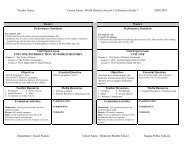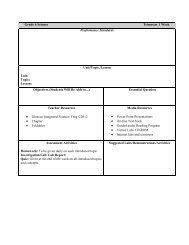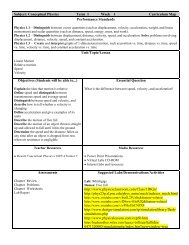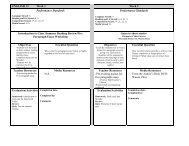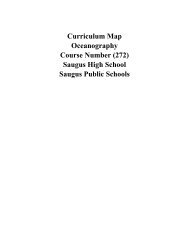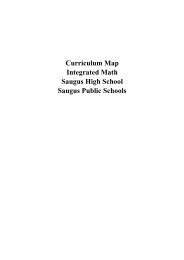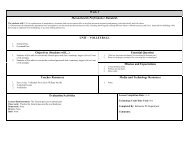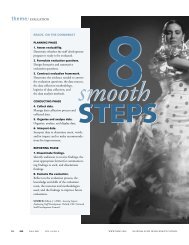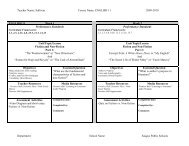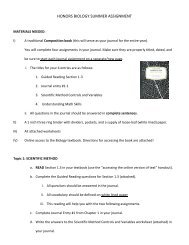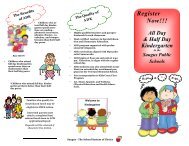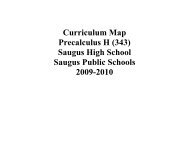Intro to Calculus Curriculum Map CCSS - Saugus Public Schools
Intro to Calculus Curriculum Map CCSS - Saugus Public Schools
Intro to Calculus Curriculum Map CCSS - Saugus Public Schools
Create successful ePaper yourself
Turn your PDF publications into a flip-book with our unique Google optimized e-Paper software.
<strong>Curriculum</strong> <strong>Map</strong><br />
<strong>Intro</strong>duction <strong>to</strong> <strong>Calculus</strong><br />
<strong>Saugus</strong> High School<br />
<strong>Saugus</strong> <strong>Public</strong> <strong>Schools</strong>
The Standards for Mathematical Practice<br />
The Standards for Mathematical Practice describe varieties of expertise that mathematics educa<strong>to</strong>rs at all levels should seek <strong>to</strong> develop<br />
in their students. These practices rest on the following two sets of important “processes and proficiencies,” each of which has<br />
longstanding importance in mathematics education:<br />
• The NCTM process standards<br />
o problem solving<br />
o reasoning and proof<br />
o communication<br />
o representation<br />
o connections<br />
• The strands of mathematical proficiency specified in the National Research Council’s report “Adding It Up”<br />
o adaptive reasoning<br />
o strategic competence<br />
o conceptual understanding (comprehension of mathematical concepts, operations, and relations)<br />
o procedural fluency (skill in carrying out procedures flexibly, accurately, efficiently, and appropriately)<br />
o productive disposition (habitual inclination <strong>to</strong> see mathematics as sensible, useful, and worthwhile, coupled<br />
with a belief in diligence and one’s own efficacy)<br />
1. Make sense of problems and persevere in solving them.<br />
Mathematically proficient students start by explaining <strong>to</strong> themselves the meaning of a problem and looking for entry points <strong>to</strong> its<br />
solution. They analyze givens, constraints, relationships, and goals. They make conjectures about the form and meaning of the<br />
solution and plan a solution pathway rather than simply jumping in<strong>to</strong> a solution attempt. They consider analogous problems, and<br />
try special cases and simpler forms of the original problem in order <strong>to</strong> gain insight in<strong>to</strong> its solution. They moni<strong>to</strong>r and evaluate<br />
their progress and change course if necessary. Older students might, depending on the context of the problem, transform algebraic<br />
expressions or change the viewing window on their graphing calcula<strong>to</strong>r <strong>to</strong> get the information they need. Mathematically<br />
proficient students can explain correspondences between equations, verbal descriptions, tables, and graphs or draw diagrams of<br />
important features and relationships, graph data, and search for regularity or trends. Younger students might rely on using<br />
concrete objects or pictures <strong>to</strong> help conceptualize and solve a problem. Mathematically proficient students check their answers <strong>to</strong><br />
problems using a different method, and they continually ask themselves, “Does this make sense?” They can understand the<br />
approaches of others <strong>to</strong> solving complex problems and identify correspondences between different approaches.<br />
2. Reason abstractly and quantitatively.<br />
Mathematically proficient students make sense of the quantities and their relationships in problem situations. Students bring two<br />
complementary abilities <strong>to</strong> bear on problems involving quantitative relationships: the ability <strong>to</strong> decontextualize—<strong>to</strong> abstract a<br />
given situation and represent it symbolically, and manipulate the representing symbols as if they have a life of their own, without<br />
necessarily attending <strong>to</strong> their referents—and the ability <strong>to</strong> contextualize, <strong>to</strong> pause as needed during the manipulation process in<br />
order <strong>to</strong> probe in<strong>to</strong> the referents for the symbols involved. Quantitative reasoning entails habits of creating a coherent<br />
representation of the problem at hand; considering the units involved; attending <strong>to</strong> the meanings of quantities, not just how <strong>to</strong><br />
compute them; and knowing and flexibly using different properties of operations and objects.<br />
3. Construct viable arguments and critique the reasoning of others.<br />
Mathematically proficient students understand and use stated assumptions, definitions, and previously established results in<br />
constructing arguments. They make conjectures and build a logical progression of statements <strong>to</strong> explore the truth of their<br />
conjectures. They are able <strong>to</strong> analyze situations by breaking them in<strong>to</strong> cases, and can recognize and use counterexamples. They<br />
justify their conclusions, communicate them <strong>to</strong> others, and respond <strong>to</strong> the arguments of others. They reason inductively about<br />
data, making plausible arguments that take in<strong>to</strong> account the context from which the data arose. Mathematically proficient students<br />
are also able <strong>to</strong> compare the effectiveness of two plausible arguments, distinguish correct logic or reasoning from that which is<br />
flawed, and—if there is a flaw in an argument—explain what it is. Elementary students can construct arguments using concrete<br />
referents such as objects, drawings, diagrams, and actions. Such arguments can make sense and be correct, even though they are<br />
not generalized or made formal until later grades. Later, students learn <strong>to</strong> determine domains <strong>to</strong> which an argument applies.<br />
Students at all grades can listen or read the arguments of others, decide whether they make sense, and ask useful questions <strong>to</strong><br />
clarify or improve the arguments.
4. Model with mathematics.<br />
Mathematically proficient students can apply the mathematics they know <strong>to</strong> solve problems arising in everyday life, society, and<br />
the workplace. In early grades, this might be as simple as writing an addition equation <strong>to</strong> describe a situation. In middle grades, a<br />
student might apply proportional reasoning <strong>to</strong> plan a school event or analyze a problem in the community. By high school, a<br />
student might use geometry <strong>to</strong> solve a design problem or use a function <strong>to</strong> describe how one quantity of interest depends on<br />
another. Mathematically proficient students who can apply what they know are comfortable making assumptions and<br />
approximations <strong>to</strong> simplify a complicated situation, realizing that these may need revision later. They are able <strong>to</strong> identify<br />
important quantities in a practical situation and map their relationships using such <strong>to</strong>ols as diagrams, two-way tables, graphs,<br />
flowcharts and formulas. They can analyze those relationships mathematically <strong>to</strong> draw conclusions. They routinely interpret their<br />
mathematical results in the context of the situation and reflect on whether the results make sense, possibly improving the model if<br />
it has not served its purpose.<br />
5. Use appropriate <strong>to</strong>ols strategically.<br />
Mathematically proficient students consider the available <strong>to</strong>ols when solving a mathematical problem. These <strong>to</strong>ols might include<br />
pencil and paper, concrete models, a ruler, a protrac<strong>to</strong>r, a calcula<strong>to</strong>r, a spreadsheet, a computer algebra system, a statistical<br />
package, or dynamic geometry software. Proficient students are sufficiently familiar with <strong>to</strong>ols appropriate for their grade or<br />
course <strong>to</strong> make sound decisions about when each of these <strong>to</strong>ols might be helpful, recognizing both the insight <strong>to</strong> be gained and<br />
their limitations. For example, mathematically proficient high school students analyze graphs of functions and solutions generated<br />
using a graphing calcula<strong>to</strong>r. They detect possible errors by strategically using estimation and other mathematical knowledge.<br />
When making mathematical models, they know that technology can enable them <strong>to</strong> visualize the results of varying assumptions,<br />
explore consequences, and compare predictions with data. Mathematically proficient students at various grade levels are able <strong>to</strong><br />
identify relevant external mathematical resources, such as digital content located on a website, and use them <strong>to</strong> pose or solve<br />
problems. They are able <strong>to</strong> use technological <strong>to</strong>ols <strong>to</strong> explore and deepen their understanding of concepts.<br />
6. Attend <strong>to</strong> precision.<br />
Mathematically proficient students try <strong>to</strong> communicate precisely <strong>to</strong> others. They try <strong>to</strong> use clear definitions in discussion with<br />
others and in their own reasoning. They state the meaning of the symbols they choose, including using the equal sign consistently<br />
and appropriately. They are careful about specifying units of measure, and labeling axes <strong>to</strong> clarify the correspondence with<br />
quantities in a problem. They calculate accurately and efficiently, express numerical answers with a degree of precision<br />
appropriate for the problem context. In the elementary grades, students give carefully formulated explanations <strong>to</strong> each other. By<br />
the time they reach high school they have learned <strong>to</strong> examine claims and make explicit use of definitions.<br />
7. Look for and make use of structure.<br />
Mathematically proficient students look closely <strong>to</strong> discern a pattern or structure. Young students, for example, might notice that<br />
three and seven more is the same amount as seven and three more, or they may sort a collection of shapes according <strong>to</strong> how many<br />
sides the shapes have. Later, students will see 7 × 8 equals the well-remembered 7 × 5 + 7 × 3, in preparation for learning about<br />
the distributive property. In the expression x 2 + 9x + 14, older students can see the 14 as 2 × 7 and the 9 as 2 + 7. They recognize<br />
the significance of an existing line in a geometric figure and can use the strategy of drawing an auxiliary line for solving<br />
problems. They also can step back for an overview and shift perspective. They can see complicated things, such as some algebraic<br />
expressions, as single objects or as being composed of several objects. For example, they can see 5 – 3(x – y) 2 as 5 minus a<br />
positive number times a square, and use that <strong>to</strong> realize that its value cannot be more than 5 for any real numbers x and y.<br />
8. Look for and express regularity in repeated reasoning.<br />
Mathematically proficient students notice if calculations are repeated, and look both for general methods and for shortcuts. Upper<br />
elementary students might notice when dividing 25 by 11 that they are repeating the same calculations over and over again, and<br />
conclude they have a repeating decimal. By paying attention <strong>to</strong> the calculation of slope as they repeatedly check whether points<br />
are on the line through (1, 2) with slope 3, middle school students might abstract the equation (y – 2)/(x – 1) = 3. Noticing the<br />
regularity in the way terms cancel when expanding (x – 1)(x + 1), (x – 1)(x 2 + x + 1), and (x – 1)(x 3 + x 2 + x + 1) might lead them<br />
<strong>to</strong> the general formula for the sum of a geometric series. As they work <strong>to</strong> solve a problem, mathematically proficient students<br />
maintain oversight of the process, while attending <strong>to</strong> the details. They continually evaluate the reasonableness of their<br />
intermediate results.
Connecting the Standards for Mathematical Practice <strong>to</strong> the Standards for Mathematical<br />
Content<br />
The Standards for Mathematical Practice describe ways in which developing student practitioners of the discipline of mathematics<br />
increasingly ought <strong>to</strong> engage with the subject matter as they grow in mathematical maturity and expertise throughout the elementary,<br />
middle, and high school years. Designers of curricula, assessments, and professional development should all attend <strong>to</strong> the need <strong>to</strong><br />
connect the mathematical practices <strong>to</strong> mathematical content in mathematics instruction.<br />
The Standards for Mathematical Content are a balanced combination of procedure and understanding. Expectations that begin with the<br />
word “understand” are often especially good opportunities <strong>to</strong> connect the practices <strong>to</strong> the content. Students who lack understanding of<br />
a <strong>to</strong>pic may rely on procedures <strong>to</strong>o heavily. Without a flexible base from which <strong>to</strong> work, they may be less likely <strong>to</strong> consider analogous<br />
problems, represent problems coherently, justify conclusions, apply the mathematics <strong>to</strong> practical situations, use technology mindfully<br />
<strong>to</strong> work with the mathematics, explain the mathematics accurately <strong>to</strong> other students, step back for an overview, or deviate from a<br />
known procedure <strong>to</strong> find a shortcut. In short, a lack of understanding effectively prevents a student from engaging in the mathematical<br />
practices.<br />
In this respect, those content standards which set an expectation of understanding are potential “points of intersection” between the<br />
Standards for Mathematical Content and the Standards for Mathematical Practice. These points of intersection are intended <strong>to</strong> be<br />
weighted <strong>to</strong>ward central and generative concepts in the school mathematics curriculum that most merit the time, resources, innovative<br />
energies, and focus necessary <strong>to</strong> qualitatively improve the curriculum, instruction, assessment, professional development, and student<br />
achievement in mathematics.
<strong>Intro</strong>duction <strong>to</strong> <strong>Calculus</strong> Term One Week 1<br />
Common Core Standards<br />
F-IF-4 For a function that models a relationship between two quantities, interpret key features of graphs and<br />
tables in terms of the quantities, and sketch graphs showing key features given a verbal description of the<br />
relationship. Key features include: intercepts; intervals where the function is increasing, decreasing, positive,<br />
or negative; relative maximums and minimums; symmetries; end behavior; and periodicity.<br />
• What is a Function (F-IF-4)<br />
• Basic Functions and Transformations (F-IF-4)<br />
• Basic Functions and Transformations (F-IF-4)<br />
• Linear Functions (F-IF-4)<br />
• Exponential Functions (F-IF-4)<br />
Objectives<br />
The students will be able <strong>to</strong>…<br />
• understand the nature of a function, including<br />
graphs, domain, range, and zeros.<br />
• apply transformations <strong>to</strong> points and sets of<br />
points.<br />
• identify parent functions from graphs and<br />
equations.<br />
• write equations for linear functions.<br />
• determine if a function is linear.<br />
• write exponential equations.<br />
• graph exponential equations.<br />
• transform exponential functions.<br />
Unit One<br />
Functions and Graphs<br />
Essential Question<br />
How does changing the input or the output of a<br />
function effect its transformation?<br />
Teacher Resources<br />
<strong>Calculus</strong>: Concepts and Calcula<strong>to</strong>rs ©2006<br />
• Chapter One lessons<br />
• Kuta software<br />
Media Resources<br />
Assessments<br />
Homework: To be given daily on each introduced<br />
<strong>to</strong>pic.<br />
Class Discussion: Students will be expected <strong>to</strong> be<br />
prepared for class, participate in class activities and<br />
actively engage in class discussion.<br />
Suggested Instructional Practices<br />
• Exploration C1. 2012.1 – Linear Functions<br />
(See MathShared Resources)
<strong>Intro</strong>duction <strong>to</strong> <strong>Calculus</strong> Term One Week 2<br />
Common Core Standards<br />
F-BF-4 Find inverse functions.<br />
F-LE-1 Distinguish between situations that can be modeled with linear functions and with exponential<br />
functions.<br />
F-BF-4c Read values of an inverse function from a graph or a table, given that the function has an inverse.<br />
Unit One<br />
Functions and Graphs<br />
• Exponential Functions (F-LE-1)<br />
• Inverse Functions (F-BF-4, F-BF-4c)<br />
Objectives<br />
The students will be able <strong>to</strong>…<br />
• transform exponential functions.<br />
• identify exponential growth and decay<br />
functions.<br />
• determine if an inverse is a function.<br />
• write and graph inverse equations.<br />
Essential Question<br />
What is the inverse of a function and how can it be<br />
represented graphically and algebraically?<br />
Teacher Resources<br />
<strong>Calculus</strong>: Concepts and Calcula<strong>to</strong>rs ©2006<br />
• Chapter One lessons<br />
• Kuta software<br />
Media Resources<br />
Assessments<br />
Homework: To be given daily on each introduced<br />
<strong>to</strong>pic.<br />
Class Discussion: Students will be expected <strong>to</strong> be<br />
prepared for class, participate in class activities and<br />
actively engage in class discussion.<br />
Quiz: on concepts involving Types of Functions.<br />
Suggested Instructional Practices<br />
Investigation – C. 2012. 2 – Inverse<br />
Functions (See MathShared Resources)
<strong>Intro</strong>duction <strong>to</strong> <strong>Calculus</strong> Term One Week 3<br />
Common Core Standards<br />
F-BF-4b Verify by composition that one function is the inverse of another.<br />
F-BF-5 Understand the inverse relationship between exponents and logarithms and use this relationship <strong>to</strong><br />
solve problems involving logarithms and exponents.<br />
• Logarithms (F-BF-5)<br />
• Combining Functions (F-BF-4b)<br />
Unit One<br />
Functions and Graphs<br />
Objectives<br />
The students will be able <strong>to</strong>…<br />
• evaluate logarithmic expressions.<br />
• use the properties of logarithms <strong>to</strong> solve<br />
logarithmic equations.<br />
• combine functions by adding, subtracting,<br />
multiplying or dividing <strong>to</strong> produce new<br />
functions.<br />
Essential Question<br />
What is the inverse of a function and how can it be<br />
represented graphically and algebraically?<br />
Teacher Resources<br />
<strong>Calculus</strong>: Concepts and Calcula<strong>to</strong>rs ©2006<br />
• Chapter One lessons<br />
• Kuta software<br />
Media Resources<br />
Assessments<br />
Homework: To be given daily on each introduced<br />
<strong>to</strong>pic.<br />
Class Discussion: Students will be expected <strong>to</strong> be<br />
prepared for class, participate in class activities and<br />
actively engage in class discussion.<br />
Quiz: on concepts involving Exponential, Inverse<br />
and Logarithmic Functions.<br />
Suggested Instructional Practices
<strong>Intro</strong>duction <strong>to</strong> <strong>Calculus</strong> Term One Week 4<br />
Common Core Standards<br />
F-IF-7 Graph functions expressed symbolically and show key features of the graph, by hand in simple cases<br />
and using technology for more complicated cases.<br />
F-IF- 7d Graph rational functions, identifying zeros and asymp<strong>to</strong>tes when suitable fac<strong>to</strong>rizations are<br />
available, and showing end behavior.<br />
Unit One<br />
Functions and Graphs<br />
• Polynomial Functions (F-IF-7)<br />
• Rational Functions (F-IF- 7d)<br />
Objectives<br />
The students will be able <strong>to</strong>…<br />
• investigate graphs of polynomial functions.<br />
• determine roots of polynomial functions by<br />
fac<strong>to</strong>ring.<br />
• graph rational functions.<br />
• investigate properties of a rational function.<br />
Essential Question<br />
How are the GCF and the distributive property used<br />
<strong>to</strong> fac<strong>to</strong>r polynomials?<br />
Teacher Resources<br />
Precalculus ©2006<br />
• Chapter Seven lessons<br />
• Kuta software<br />
Media Resources<br />
Assessments<br />
Suggested Instructional Practices<br />
Homework: To be given daily on each introduced<br />
<strong>to</strong>pic.<br />
Class Discussion: Students will be expected <strong>to</strong> be<br />
prepared for class, participate in class activities and<br />
actively engage in class discussion.<br />
Test: On concepts involving Functions and Graphs.
<strong>Intro</strong>duction <strong>to</strong> <strong>Calculus</strong> Term One Week 5<br />
Common Core Standards<br />
F-TF-4 Use the unit circle <strong>to</strong> explain symmetry (odd and even) and periodicity of trigonometric functions.<br />
• Graphs of Trigonometric Functions (F-TF-4)<br />
• Periodic Graphs and Amplitudes (F-TF-4)<br />
Unit Two<br />
Trigonometric Functions<br />
Objectives<br />
The students will be able <strong>to</strong>…<br />
• graph sine and cosine functions.<br />
• determine amplitude and period of a<br />
trigonometric function.<br />
• review unit circle properties.<br />
Essential Question<br />
What is the relationship between amplitude and<br />
period of a trigonometric function?<br />
Teacher Resources<br />
Precalculus ©2006<br />
• Chapter Nine lessons<br />
• Kuta software<br />
Media Resources<br />
Assessments<br />
Suggested Instructional Practices<br />
Homework: To be given daily on each introduced<br />
<strong>to</strong>pic.<br />
Class Discussion: Students will be expected <strong>to</strong> be<br />
prepared for class, participate in class activities and<br />
actively engage in class discussion.
<strong>Intro</strong>duction <strong>to</strong> <strong>Calculus</strong> Term One Week 6<br />
Common Core Standards<br />
F-TF-9 Prove the addition and subtraction formulas for sine, cosine, and tangent and use them <strong>to</strong> solve<br />
problems.<br />
F-TF-4 Use the unit circle <strong>to</strong> explain symmetry (odd and even) and periodicity of trigonometric functions.<br />
Unit Two<br />
Trigonometric Functions<br />
• Periodic Graphs and Phase Shifts (F-TF-4)<br />
• Trigonometric Identities (F-TF-9)<br />
Objectives<br />
The students will be able <strong>to</strong>…<br />
• transform periodic functions using phase shifts.<br />
• simplify trigonometric expressions using<br />
trigonometric identities.<br />
Essential Question<br />
Why are trigonometric identities useful?<br />
Teacher Resources<br />
Precalculus ©2006<br />
• Chapter Nine lessons<br />
• Kuta software<br />
Media Resources<br />
Assessments<br />
Suggested Instructional Practices<br />
Homework: To be given daily on each introduced<br />
<strong>to</strong>pic.<br />
Class Discussion: Students will be expected <strong>to</strong> be<br />
prepared for class, participate in class activities and<br />
actively engage in class discussion.<br />
Quiz: on concepts involving Graphs of<br />
Trigonometric Functions.
<strong>Intro</strong>duction <strong>to</strong> <strong>Calculus</strong> Term One Week 7<br />
Common Core Standards<br />
F-TF-9 Prove the addition and subtraction formulas for sine, cosine, and tangent and use them <strong>to</strong> solve<br />
problems.<br />
• Trigonometric Identities (F-TF-9)<br />
Unit Two<br />
Trigonometric Functions<br />
Objectives<br />
The students will be able <strong>to</strong>…<br />
• simplify trigonometric expressions using sum<br />
and difference trigonometric identities.<br />
• simplify trigonometric expressions using<br />
double and half angle trigonometric identities.<br />
Essential Question<br />
Why are trigonometric identities useful?<br />
Teacher Resources<br />
Precalculus ©2006<br />
Media Resources<br />
• Chapter Ten lessons<br />
Assessments<br />
Suggested Instructional Practices<br />
Homework: To be given daily on each introduced<br />
<strong>to</strong>pic.<br />
Class Discussion: Students will be expected <strong>to</strong> be<br />
prepared <strong>to</strong> classroom activities and actively<br />
participate in class discussion.<br />
Quiz: on concepts involving Trigonometric<br />
Identities.
<strong>Intro</strong>duction <strong>to</strong> <strong>Calculus</strong> Term One Week 8<br />
Common Core Standards<br />
F-TF-9 Prove the addition and subtraction formulas for sine, cosine, and tangent and use them <strong>to</strong> solve<br />
problems.<br />
Unit Two<br />
Trigonometric Functions<br />
• Solving Trigonometric Equations (F-TF-9)<br />
Objectives<br />
The students will be able <strong>to</strong>…<br />
• solve trigonometric equations using<br />
trigonometric identities.<br />
Essential Question<br />
Why are trigonometric identities useful?<br />
Teacher Resources<br />
Precalculus ©2006<br />
Media Resources<br />
• Chapter Ten lessons<br />
Assessments<br />
Suggested Instructional Practices<br />
Homework: To be given daily on each introduced<br />
<strong>to</strong>pic.<br />
Class Discussion: Students will be expected <strong>to</strong> be<br />
prepared for class, participate in class activities and<br />
actively engage in class discussion.<br />
Test: On concepts involving Trigonometric<br />
Functions
<strong>Intro</strong>duction <strong>to</strong> <strong>Calculus</strong> Term Two Week 1<br />
Common Core Standards<br />
• Limits of Functions<br />
• Properties of Limits<br />
Unit Three<br />
Limits and Continuity<br />
Objectives<br />
The students will be able <strong>to</strong>…<br />
• determine a limit given a graph.<br />
• explore right handed and left handed limits.<br />
• determine a limit given an equation.<br />
• determine infinite limits.<br />
Essential Question<br />
How do you determine the limit of a<br />
function and how does that relate <strong>to</strong> the<br />
continuity of that function?<br />
Teacher Resources<br />
Precalculus ©2006<br />
Media Resources<br />
• Chapter Fourteen lessons<br />
Assessments<br />
Suggested Instructional Practices<br />
Homework: To be given daily on each introduced<br />
<strong>to</strong>pic.<br />
Class Discussion: Students will be expected <strong>to</strong> be<br />
prepared for class, participate in class activities and<br />
actively engage in class discussion.<br />
Quiz: on concepts involving Limits and Properties<br />
of Limits.
<strong>Intro</strong>duction <strong>to</strong> <strong>Calculus</strong> Term Two Week 2<br />
Common Core Standards<br />
• Limits at Infinity<br />
Unit Three<br />
Limits and Continuity<br />
Objectives<br />
The students will be able <strong>to</strong>…<br />
• determine the limit at infinity.<br />
• determine limits at infinity – graphically and<br />
numerically.<br />
Essential Question<br />
How do you determine the limit of a<br />
function and how does that relate <strong>to</strong> the<br />
continuity of that function?<br />
Teacher Resources<br />
Precalculus ©2006<br />
Media Resources<br />
• Chapter Fourteen lessons<br />
Assessments<br />
Suggested Instructional Practices<br />
Homework: To be given daily on each introduced<br />
<strong>to</strong>pic.<br />
Class Discussion: Students will be expected <strong>to</strong> be<br />
prepared for class, participate in class activities and<br />
actively engage in class discussion.<br />
Quiz: on concepts involving Limits at Infinity.
<strong>Intro</strong>duction <strong>to</strong> <strong>Calculus</strong> Term Two Week 3<br />
Common Core Standards<br />
• Continuity<br />
• Continuous and Discontinuous Functions<br />
• Properties of Continuous Functions<br />
Unit Three<br />
Limits and Continuity<br />
Objectives<br />
The students will be able <strong>to</strong>…<br />
• identify the continuity of a limit.<br />
• describe types of discontinuity.<br />
• find values of discontinuity.<br />
Essential Question<br />
How do you determine the limit of a<br />
function and how does that relate <strong>to</strong> the<br />
continuity of that function?<br />
Teacher Resources<br />
Precalculus ©2006<br />
Media Resources<br />
• Chapter Fourteen lessons<br />
Assessments<br />
Suggested Instructional Practices<br />
Homework: To be given daily on each introduced<br />
<strong>to</strong>pic.<br />
Class Discussion: Students will be expected <strong>to</strong> be<br />
prepared for class, participate in class activities and<br />
actively engage in class discussion.<br />
Test: On concepts involving Limits and Continuity.
<strong>Intro</strong>duction <strong>to</strong> <strong>Calculus</strong> Term Two Week 4<br />
Common Core Standards<br />
• The Concept of the Derivative<br />
• Average Rate of Change<br />
Unit Four<br />
Derivatives<br />
Objectives<br />
The students will be able <strong>to</strong>…<br />
• understand the concept of the derivative.<br />
• evaluate the average rate of change.<br />
Essential Question<br />
How does the derivative represent an<br />
instantaneous rate of change?<br />
Teacher Resources<br />
Precalculus ©2006<br />
Media Resources<br />
• Chapter Fourteen lessons<br />
Assessments<br />
Homework: To be given daily on each introduced<br />
<strong>to</strong>pic.<br />
Class Discussion: Students will be expected <strong>to</strong> be<br />
prepared for class, participate in class activities and<br />
actively engage in class discussion.<br />
Suggested Instructional Practices<br />
• LTF Activity C1. 2012.3 – Round Trip<br />
Drive (See MathShared Resources)<br />
• LTF Activity C1. 2012.4 – Road Trip (See<br />
MathShared Resources)
<strong>Intro</strong>duction <strong>to</strong> <strong>Calculus</strong> Term Two Week 5<br />
Common Core Standards<br />
• Average Rate of Change<br />
• Difference Quotient<br />
Unit Four<br />
Derivatives<br />
Objectives<br />
The students will be able <strong>to</strong>…<br />
• use the difference quotient <strong>to</strong> find the slope of<br />
the secant line through two points.<br />
• evaluate the average rate of change.<br />
Essential Question<br />
How does the derivative represent an<br />
instantaneous rate of change?<br />
Teacher Resources<br />
<strong>Calculus</strong> – Larson ©1990<br />
Media Resources<br />
• Chapter Two lessons<br />
Assessments<br />
Suggested Instructional Practices<br />
Homework: To be given daily on each introduced<br />
<strong>to</strong>pic.<br />
Class Discussion: Students will be expected <strong>to</strong> be<br />
prepared for class, participate in class activities and<br />
actively engage in class discussion.
<strong>Intro</strong>duction <strong>to</strong> <strong>Calculus</strong> Term Two Week 6<br />
Common Core Standards<br />
• Difference Quotient<br />
• The Derivative by the Limit Process<br />
Unit Four<br />
Derivatives<br />
Objectives<br />
The students will be able <strong>to</strong>…<br />
• use the difference quotient <strong>to</strong> find the slope of<br />
the secant line through two points.<br />
• evaluate the average rate of change.<br />
• find the derivative at a given point.<br />
Essential Question<br />
How does the derivative represent an<br />
instantaneous rate of change?<br />
Teacher Resources<br />
<strong>Calculus</strong> – Larson ©1990<br />
Media Resources<br />
• Chapter Two lessons<br />
Assessments<br />
Suggested Instructional Practices<br />
Homework: To be given daily on each introduced<br />
<strong>to</strong>pic.<br />
Class Discussion: Students will be expected <strong>to</strong> be<br />
prepared for class, participate in class activities and<br />
actively engage in class discussion.<br />
Quiz: on concepts involving Average Rate of<br />
Change and the Difference Quotient.
<strong>Intro</strong>duction <strong>to</strong> <strong>Calculus</strong> Term Two Week 7<br />
Common Core Standards<br />
• The Derivative and the Tangent Line<br />
Unit Four<br />
Derivatives<br />
Objectives<br />
The students will be able <strong>to</strong>…<br />
• find the slope of a tangent line <strong>to</strong> a curve.<br />
Essential Question<br />
How does the derivative represent an<br />
instantaneous rate of change?<br />
Teacher Resources<br />
<strong>Calculus</strong> – Larson ©1990<br />
Media Resources<br />
• Chapter Two lessons<br />
Assessments<br />
Suggested Instructional Practices<br />
Homework: To be given daily on each introduced<br />
<strong>to</strong>pic.<br />
Class Discussion: Students will be expected <strong>to</strong> be<br />
prepared for class, participate in class activities and<br />
actively engage in class discussion.<br />
Test: On concepts involving Derivatives.
<strong>Intro</strong>duction <strong>to</strong> <strong>Calculus</strong> Term Two Week 8<br />
Common Core Standards<br />
Unit Five<br />
Rules of Differentiation<br />
• The Derivative – Rules of Differentiation ( Sum and Difference)<br />
• The Derivative – Finding the derivative two ways (product rule)<br />
Objectives<br />
The students will be able <strong>to</strong>…<br />
• find the derivative at a given point.<br />
• calculate the derivative using sum and<br />
difference rules.<br />
• calculate the derivative using the product rule<br />
and multiplying out.<br />
Essential Question<br />
How does the derivative represent an<br />
instantaneous rate of change?<br />
Teacher Resources<br />
<strong>Calculus</strong> – Larson ©1990<br />
Media Resources<br />
• Chapter Two lessons<br />
Assessments<br />
Suggested Instructional Practices<br />
Homework: To be given daily on each introduced<br />
<strong>to</strong>pic.<br />
Class Discussion: Students will be expected <strong>to</strong> be<br />
prepared for class, participate in class activities and<br />
actively engage in class discussion.<br />
Mid-Year Exam: This will cover all of the concepts<br />
from semester one.
<strong>Intro</strong>duction <strong>to</strong> <strong>Calculus</strong> Term Three Week 1<br />
Common Core Standards<br />
Unit Five<br />
Rules of Differentiation<br />
• The Derivative – Rules of Differentiation – Chain Rule<br />
Objectives<br />
The students will be able <strong>to</strong>…<br />
• use Differentiation rules <strong>to</strong> determine the<br />
derivative – chain rule.<br />
Essential Question<br />
How does the derivative represent an<br />
instantaneous rate of change?<br />
Teacher Resources<br />
<strong>Calculus</strong> – Larson ©1990<br />
Media Resources<br />
• Chapter Two lessons<br />
Assessments<br />
Suggested Instructional Practices<br />
Homework: To be given daily on each introduced<br />
<strong>to</strong>pic.<br />
Class Discussion: Students will be expected <strong>to</strong> be<br />
prepared for class, participate in class activities and<br />
actively engage in class discussion.<br />
Quiz: on concepts involving Rules of<br />
Differentiation.
<strong>Intro</strong>duction <strong>to</strong> <strong>Calculus</strong> Term Three Week 2<br />
Common Core Standards<br />
• Implicit Differentiation<br />
• Higher Order Derivatives<br />
Unit Five<br />
Rules of Differentiation<br />
Objectives<br />
The students will be able <strong>to</strong>…<br />
• use implicit differentiation <strong>to</strong> find the<br />
derivative of an equation with x and y<br />
variables.<br />
• calculate higher order derivatives.<br />
Essential Question<br />
How does the derivative represent an<br />
instantaneous rate of change?<br />
Teacher Resources<br />
<strong>Calculus</strong> – Larson ©1990<br />
Media Resources<br />
• Chapter Two lessons<br />
Assessments<br />
Suggested Instructional Practices<br />
Homework: To be given daily on each introduced<br />
<strong>to</strong>pic.<br />
Class Discussion: Students will be expected <strong>to</strong> be<br />
prepared for class, participate in class activities and<br />
actively engage in class discussion.
<strong>Intro</strong>duction <strong>to</strong> <strong>Calculus</strong> Term Three Week 3<br />
Common Core Standards<br />
• Derivatives of Sine and Cosine Functions<br />
Unit Five<br />
Rules of Differentiation<br />
Objectives<br />
The students will be able <strong>to</strong>…<br />
• evaluate derivatives of trigonometric<br />
functions.<br />
Essential Question<br />
How does the derivative represent an instantaneous<br />
rate of change?<br />
Teacher Resources<br />
<strong>Calculus</strong> – Larson ©1990<br />
Media Resources<br />
• Chapter Three lessons<br />
Assessments<br />
Suggested Instructional Practices<br />
Homework: To be given daily on each introduced<br />
<strong>to</strong>pic.<br />
Class Discussion: Students will be expected <strong>to</strong> be<br />
prepared for class, participate in class activities and<br />
actively engage in class discussion.<br />
Test: On concepts involving Rules of<br />
Differentiation.
<strong>Intro</strong>duction <strong>to</strong> <strong>Calculus</strong> Term Three Week 4<br />
Common Core Standards<br />
• Basic Antiderivative Rules<br />
• Initial Values<br />
• U-Substitution<br />
Objectives<br />
The students will be able <strong>to</strong>…<br />
• find the general antiderivatives<br />
of various functions.<br />
• use differentiation rules <strong>to</strong><br />
determine antiderivatives.<br />
• integrate a product by inversing<br />
the Chain Rule.<br />
Unit Six<br />
Anitderivatives<br />
Essential Question<br />
Why is integrating a product of two<br />
functions possible and when can you<br />
integrate these products?<br />
Teacher Resources<br />
<strong>Calculus</strong> – Larson ©1990<br />
• Chapter Three lessons<br />
Media Resources<br />
Assessments<br />
Suggested Instructional Practices<br />
Homework: To be given daily on each introduced<br />
<strong>to</strong>pic.<br />
Class Discussion: Students will be expected <strong>to</strong> be<br />
prepared for class, participate in class activities and<br />
actively engage in class discussion.
<strong>Intro</strong>duction <strong>to</strong> <strong>Calculus</strong> Term Three Week 5<br />
Common Core Standards<br />
• U-Substitution<br />
• Fundamental Theorem of <strong>Calculus</strong><br />
Unit Six<br />
Anitderivatives<br />
Objectives<br />
The students will be able <strong>to</strong>…<br />
• integrate a product by inversing<br />
the Chain Rule.<br />
• find the area under a curve using the<br />
fundamental theorem of calculus.<br />
• find the area between two curves using the<br />
fundamental theorem of calculus.<br />
Essential Question<br />
Why is integrating a product of two<br />
functions possible and when can you<br />
integrate these products?<br />
Teacher Resources<br />
<strong>Calculus</strong> – Larson ©1990<br />
Media Resources<br />
• Chapter Three lessons<br />
Assessments<br />
Suggested Instructional Practices<br />
Homework: To be given daily on each introduced<br />
<strong>to</strong>pic.<br />
Class Discussion: Students will be expected <strong>to</strong> be<br />
prepared for class, participate in class activities and<br />
actively engage in class discussion.<br />
Quiz: on concepts involving Antiderivative Rules<br />
and U-Substitution.
<strong>Intro</strong>duction <strong>to</strong> <strong>Calculus</strong> Term Three Week 6<br />
Common Core Standards<br />
Unit Six<br />
Anitderivatives<br />
• Fundamental Theorem of <strong>Calculus</strong> (area under the curve, area between two curves)<br />
Objectives<br />
The students will be able <strong>to</strong>…<br />
• find the area under a curve using the<br />
fundamental theorem of calculus.<br />
• find the area between two curves using the<br />
fundamental theorem of calculus.<br />
Essential Question<br />
Why is integrating a product of two<br />
functions possible and when can you<br />
integrate these products?<br />
Teacher Resources<br />
<strong>Calculus</strong> – Larson ©1990<br />
Media Resources<br />
• Chapter Three lessons<br />
Assessments<br />
Suggested Instructional Practices<br />
Homework: To be given daily on each introduced<br />
<strong>to</strong>pic.<br />
Class Discussion: Students will be expected <strong>to</strong> be<br />
prepared for class, participate in class activities and<br />
actively engage in class discussion.<br />
Test: On concepts involving Antiderivatives.
<strong>Intro</strong>duction <strong>to</strong> <strong>Calculus</strong> Term Three Week 7<br />
Common Core Standards<br />
N-VM-1 Recognize vec<strong>to</strong>r quantities as having both magnitude and direction. Represent vec<strong>to</strong>r quantities by<br />
directed line segments, and use appropriate symbols for vec<strong>to</strong>rs and their magnitudes (e.g., v, |v|, ||v||, v).<br />
N-VM-2 Find the components of a vec<strong>to</strong>r by subtracting the coordinates of an initial point from the<br />
coordinates of a terminal point.<br />
N-VM-4 Add and subtract vec<strong>to</strong>rs.<br />
N-VM-5 Multiply a vec<strong>to</strong>r by a scalar.<br />
• Properties of Vec<strong>to</strong>rs (N-VM-1, N-VM-2)<br />
• Operations with Vec<strong>to</strong>rs (N-VM-4, N-VM-5)<br />
Unit Seven<br />
Vec<strong>to</strong>rs<br />
Objectives<br />
The students will be able <strong>to</strong>…<br />
• explore the properties of vec<strong>to</strong>rs.<br />
• find the magnitude and component form of<br />
a vec<strong>to</strong>r.<br />
• perform vec<strong>to</strong>r operations algebraically<br />
and graphically.<br />
Essential Question<br />
What is the difference between a ray and a vec<strong>to</strong>r?<br />
Teacher Resources<br />
<strong>Calculus</strong> – Larson ©1990<br />
Media Resources<br />
• Chapter Three lessons<br />
Assessments<br />
Suggested Instructional Practices<br />
Homework: To be given daily on each introduced<br />
<strong>to</strong>pic.<br />
Class Discussion: Students will be expected <strong>to</strong> be<br />
prepared for class, participate in class activities and<br />
actively engage in class discussion.<br />
Quiz: on concepts involving Operations with<br />
Vec<strong>to</strong>rs.
<strong>Intro</strong>duction <strong>to</strong> <strong>Calculus</strong> Term Three Week 8<br />
Common Core Standards<br />
• Unit Vec<strong>to</strong>rs<br />
• Direction Angles of Vec<strong>to</strong>rs<br />
Objectives<br />
The students will be able <strong>to</strong>…<br />
• find unit vec<strong>to</strong>rs.<br />
• determine the direction angle of a vec<strong>to</strong>r.<br />
Unit Seven<br />
Vec<strong>to</strong>rs<br />
Essential Question<br />
What is the difference between a ray and a vec<strong>to</strong>r?<br />
Teacher Resources<br />
<strong>Calculus</strong> – Larson ©1990<br />
Media Resources<br />
• Chapter Three lessons<br />
Assessments<br />
Suggested Instructional Practices<br />
Homework: To be given daily on each introduced<br />
<strong>to</strong>pic.<br />
Class Discussion: Students will be expected <strong>to</strong> be<br />
prepared for class, participate in class activities and<br />
actively engage in class discussion.<br />
Quiz: on concepts involving Unit Vec<strong>to</strong>rs and<br />
Direction Angles.
<strong>Intro</strong>duction <strong>to</strong> <strong>Calculus</strong> Term Four Week 1<br />
Common Core Standards<br />
• Direction Angles of a Vec<strong>to</strong>r<br />
• Resultant Force Problems<br />
Objectives<br />
The students will be able <strong>to</strong>…<br />
Unit Seven<br />
Vec<strong>to</strong>rs<br />
Essential Question<br />
What is the difference between a ray and a vec<strong>to</strong>r?<br />
• determine the resultant force given a vec<strong>to</strong>r<br />
word problem.<br />
• determine the direction angle of a vec<strong>to</strong>r.<br />
Teacher Resources<br />
<strong>Calculus</strong> – Larson ©1990<br />
Media Resources<br />
• Chapter Four lessons<br />
Assessments<br />
Suggested Instructional Practices<br />
Homework: To be given daily on each introduced<br />
<strong>to</strong>pic.<br />
Class Discussion: Students will be expected <strong>to</strong> be<br />
prepared for class, participate in class activities and<br />
actively engage in class discussion.
<strong>Intro</strong>duction <strong>to</strong> <strong>Calculus</strong> Term Four Week 2<br />
Common Core Standards<br />
• Resultant Force Problems<br />
• Dot Product<br />
• Parallel Vec<strong>to</strong>rs<br />
Objectives<br />
The students will be able <strong>to</strong>…<br />
• determine the resultant force given a vec<strong>to</strong>r<br />
word problem.<br />
• determine the direction angle of a vec<strong>to</strong>r.<br />
• find the Dot Product of a vec<strong>to</strong>r.<br />
• determine is vec<strong>to</strong>rs are parallel.<br />
Unit Seven<br />
Vec<strong>to</strong>rs<br />
Essential Question<br />
What is the difference between a ray and a vec<strong>to</strong>r?<br />
Teacher Resources<br />
<strong>Calculus</strong> – Larson ©1990<br />
Media Resources<br />
• Chapter Four lessons<br />
Assessments<br />
Suggested Instructional Practices<br />
Homework: To be given daily on each introduced<br />
<strong>to</strong>pic.<br />
Class Discussion: Students will be expected <strong>to</strong> be<br />
prepared for class, participate in class activities and<br />
actively engage in class discussion.<br />
Quiz: on concepts involving Resultant Force, Dot<br />
Product and Parallel Vec<strong>to</strong>rs.
<strong>Intro</strong>duction <strong>to</strong> <strong>Calculus</strong> Term Four Week 3<br />
Common Core Standards<br />
• Angles between Vec<strong>to</strong>rs<br />
• Orthogonal Vec<strong>to</strong>rs<br />
Objectives<br />
The students will be able <strong>to</strong>…<br />
Unit Seven<br />
Vec<strong>to</strong>rs<br />
Essential Question<br />
What is the difference between a ray and a vec<strong>to</strong>r?<br />
• determine the angles between vec<strong>to</strong>rs.<br />
• determine if vec<strong>to</strong>rs are orthogonal.<br />
Teacher Resources<br />
<strong>Calculus</strong> – Larson ©1990<br />
Media Resources<br />
• Chapter Four lessons<br />
Assessments<br />
Suggested Instructional Practices<br />
Homework: To be given daily on each introduced<br />
<strong>to</strong>pic.<br />
Class Discussion: Students will be expected <strong>to</strong> be<br />
prepared for class, participate in class activities and<br />
actively engage in class discussion.<br />
Test: on concepts involving Vec<strong>to</strong>rs.
<strong>Intro</strong>duction <strong>to</strong> <strong>Calculus</strong> Term Four Week 4<br />
Common Core Standards<br />
• Using Diagrams<br />
• Representations of Graphs<br />
Unit Eight<br />
Graph Theory<br />
Objectives<br />
The students will be able <strong>to</strong>…<br />
• use diagrams <strong>to</strong> organize situations.<br />
• explore properties of a network.<br />
• represent data in different forms of diagrams.<br />
Essential Question<br />
How is a network useful <strong>to</strong> represent and analyze<br />
data?<br />
Teacher Resources<br />
<strong>Calculus</strong> – Larson ©1990<br />
Media Resources<br />
• Chapter Four lessons<br />
Assessments<br />
Homework: To be given daily on each introduced<br />
<strong>to</strong>pic.<br />
Class Discussion: Students will be expected <strong>to</strong> be<br />
prepared for class, participate in class activities and<br />
actively engage in class discussion.<br />
Suggested Instructional Practices<br />
Modeling Project Using Diagrams.
<strong>Intro</strong>duction <strong>to</strong> <strong>Calculus</strong> Term Four Week 5<br />
Common Core Standards<br />
Unit Eight<br />
Graph Theory<br />
• Modeling Projects<br />
• Critical Paths<br />
Objectives<br />
The students will be able <strong>to</strong>…<br />
• create diagrams and graphs.<br />
• determine the least amount of time needed <strong>to</strong><br />
complete a task using critical path analysis.<br />
Essential Question<br />
How is a network useful <strong>to</strong> represent and analyze<br />
data?<br />
Teacher Resources<br />
<strong>Calculus</strong> – Larson ©1990<br />
Media Resources<br />
• Chapter Four lessons<br />
Assessments<br />
Suggested Instructional Practices<br />
Homework: To be given daily on each introduced<br />
<strong>to</strong>pic.<br />
Class Discussion: Students will be expected <strong>to</strong> be<br />
prepared for class, participate in class activities and<br />
actively engage in class discussion.
<strong>Intro</strong>duction <strong>to</strong> <strong>Calculus</strong> Term Four Week 6<br />
Common Core Standards<br />
• Graph Coloring<br />
Unit Eight<br />
Graph Theory<br />
Objectives<br />
The students will be able <strong>to</strong>…<br />
• color code diagrams using the least amount of<br />
colors possible.<br />
Essential Question<br />
How is a network useful <strong>to</strong> represent and analyze<br />
data?<br />
Teacher Resources<br />
<strong>Calculus</strong> – Larson ©1990<br />
Media Resources<br />
• Chapter Four lessons<br />
Assessments<br />
Suggested Instructional Practices<br />
Homework: To be given daily on each introduced<br />
<strong>to</strong>pic.<br />
Class Discussion: Students will be expected <strong>to</strong> be<br />
prepared for class, participate in class activities and<br />
actively engage in class discussion.<br />
Test: On concepts involving Graph Theory.




